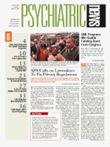Scientists have not yet determined the neurobiological basis of human consciousness—that nebulous place where the hard wiring of the human brain interfaces with thoughts, emotions, and behavior.
Yet at the same time, they are coming up with something equally pioneering and titillating: neurobiological evidence for the human unconscious state.
Two scientists doing this research are Philip Wong, Ph.D., a clinical psychologist at the New School University in New York City, and his mentor, Howard Shevrin, Ph.D., a professor of psychology at the University of Michigan in Ann Arbor.
Wong described some of their work at the December meeting of the American Psychoanalytic Association in New York City at the session “Research on the Relation of Psychoanalysis and Neuroscience: Are There Neural Correlatives of Signal Anxiety?” Shevrin was also present.
Morton Reiser, M.D., who headed up the psychiatry department at Yale University for 17 years and is now a Yale professor emeritus, chaired the session. In an interview with Psychiatric News, he pointed out that whereas “brain science deals with concrete things, matter and energy, you can measure them, weigh them, and so on,” and whereas “mental science deals with things that are immaterial, such as meaning and motive, things that are communicated in words, that come out of subjective experience,” the work of Wong and Shevrin deals with the interface of these two domains.
Their research, he declared, “essentially is showing the brain mechanism for phenomena that you study psychologically. [It] is fine work.”
Charles Fisher, M.D., a clinical professor of psychiatry at the University of California at San Francisco and coordinator of the session, agreed. As he indicated to Psychiatric News, he does not believe it is an overstatement to describe Wong and Shevrin’s experiments as “extremely important” and “frontier neurobiological evidence.”
In one of the experiments that Wong and Shevrin conducted, for instance, subjects hooked up to an electroencephalograph were consciously aware of being exposed to a face accompanied by a mild finger shock. In other words, they were being conditioned to associate the face with something unpleasant. Before, during, and after this conditioning, their brain-wave patterns were recorded. Some time later, the subjects were once again hooked up to an electroencephalograph, but this time they were quickly exposed to the face without a shock—so quickly that they were not consciously aware of seeing the face. Before, during, and after this exposure their brain-wave patterns were recorded. The researchers then compared the subjects’ brain-wave patterns from the postconditioning phase with the conditioning-phase patterns. They noted something very interesting: During the postconditioning phase, distinct slow wave brain activity occurred precisely before the point where a shock had been delivered in the conditioning phase.
This distinct slow wave brain activity, Wong and Shevrin believe, constituted neurobiological evidence for unconscious anticipation of an unpleasant event, that is, that a shock would probably be delivered along with the face. Or as Wong put it in an interview, “It does seem like, if there is an event that happened in the past, and a similar circumstance occurs in the present, then the brain is anticipating that the same kind of thing will happen that happened in the past.”
Wong and Shevrin believe that they documented neurobiological activity underlying what Freud called “signal anxiety”—anticipation of danger. And it was precisely because Wong and Shevrin’s research has implications for psychoanalysis and psychodynamic therapy that they were invited to speak at the psychoanalysts’ meeting and that some of their research results have been published in the June 1999 Journal of the American Psychoanalytic Association. ▪
